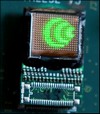Holographic Displays Coming to Smartphones
At Display Week in June, Ostendo demonstrated the culmination of nine years of work, an array of eight Quantum Photonic Imager (QPI) chips in a grid projecting  three spinning green dice—one seemingly floating behind the display, one at chip level, and the third in front of the chips.
three spinning green dice—one seemingly floating behind the display, one at chip level, and the third in front of the chips.
“Almost every display you see emits light that goes everywhere,” says Hussein El-Ghoroury, Ostendo’s CEO. “In contrast, the QPI collimates the light to a very narrow angle before emitting it, so you can emit different images in different directions.” Ostendo’s 3-D images are viewable from 2,500 perspectives.
Each of the 1 million pixels on Ostendo’s little chip consists of a layer each of red, green, and blue micro-LEDs (or lasers, in some iterations) sitting on top of its own small silicon image processor. The pixels are between 5 and 10 micrometers on a side. By modulating the power to the individual layers, each pixel can send out any color of light in a thin, focused beam. Multiple vertical waveguides carry the light out from the layers and modulate its direction—although company representatives won’t specify exactly how—and an array of microlenses focus and direct the beam further. Having an image processor under each pixel saves power and lightens the overall computational load, which is considerable for complex images because they must be simultaneously rendered for viewing from thousands of different perspectives .. read more




